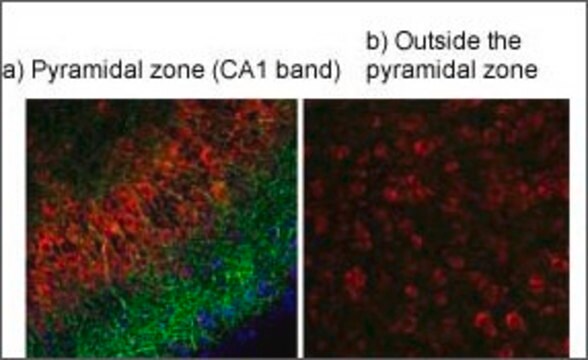SAB4200753
Anti-phospho-AKT (pThr450) antibody, Mouse monoclonal
clone AK-11, purified from hybridoma cell culture
Sinónimos:
Anti-Protein Kinase B, Anti-V-Akt Murine Thymoma Viral Oncogene Homolog 1
About This Item
Productos recomendados
origen biológico
mouse
Nivel de calidad
forma del anticuerpo
purified from hybridoma cell culture
tipo de anticuerpo
primary antibodies
clon
AK-11, monoclonal
formulario
buffered aqueous solution
mol peso
~56 kDa
reactividad de especies
mouse, chicken, rat, human
concentración
~1.0 mg/mL
técnicas
immunoblotting: 1-2 μg/mL using human breast cancer cell line MCF-7 extract
immunofluorescence: 1-2 μg/mL using mouse embryo fibroblast NIH-3T3 cells
immunoprecipitation (IP): 2-4 μg/test using whole extract of mouse embryo fibroblast NIH-3T3 cell line
isotipo
IgG2a
Nº de acceso UniProt
Condiciones de envío
dry ice
temp. de almacenamiento
−20°C
modificación del objetivo postraduccional
phosphorylation (pThr450)
Información sobre el gen
human ... AKT1(207)
Descripción general
Especificidad
Inmunógeno
Aplicación
- immunoblotting
- immunofluorescence
- immunoprecipitation
Acciones bioquímicas o fisiológicas
Forma física
Almacenamiento y estabilidad
Cláusula de descargo de responsabilidad
¿No encuentra el producto adecuado?
Pruebe nuestro Herramienta de selección de productos.
Código de clase de almacenamiento
10 - Combustible liquids
Clase de riesgo para el agua (WGK)
WGK 2
Punto de inflamabilidad (°F)
Not applicable
Punto de inflamabilidad (°C)
Not applicable
Certificados de análisis (COA)
Busque Certificados de análisis (COA) introduciendo el número de lote del producto. Los números de lote se encuentran en la etiqueta del producto después de las palabras «Lot» o «Batch»
¿Ya tiene este producto?
Encuentre la documentación para los productos que ha comprado recientemente en la Biblioteca de documentos.
Nuestro equipo de científicos tiene experiencia en todas las áreas de investigación: Ciencias de la vida, Ciencia de los materiales, Síntesis química, Cromatografía, Analítica y muchas otras.
Póngase en contacto con el Servicio técnico